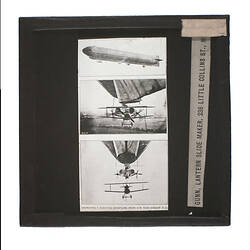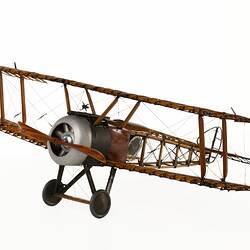Summary
Part of a collection of magic lantern slides relating to British naval history originating from the St John's Home for Boys. These slides were produced in Melbourne after the First World War with images from books and other sources. They are believed to have been used to illustrate lectures to the children in St John's Homes. Several of the slides are marked with the name 'Boreham'. This may indicate a link to Reverend Frank William Boreham (1871-1959), a noted Baptist writer and preacher who used lantern slides to illustrate talks in Melbourne and Tasmania however St John's was an Anglican institution.
Established as St John's Home for Boys in 1923, the home was located in Balwyn Road, Canterbury at 'Shrublands', a mansion formerly the property of investor & businessman John Hindson (1839-1919). His widow Alice Hindson (nee Henty) donated 'Shrublands' to the Anglican Church as a memorial to her husband and William, her late son, to be used as a home for "needy and destitute' boys on the condition it was named 'St John's'. It was officially opened on 22 November 1924 after extensive renovations to accomodate 30-40 boys, also paid for by Alice Hindson. There was a physical link with British naval history as Dame Nellie Melba donated a chapel lantern to St John's Home supposed to be one of those used by Admiral Lord Nelson in the cabin of his flagship HMS Victory. She also donated a cabin bell and wooden spars from HMS Victory. The latter were turned into candle holders.
Description of Content
Three views of the British rigid airship HMA R23 being used to conduct air launching trials with an RAF 2.F1 Sopwith Camel scout aircraft serial no. N6814. The trials were conducted at the RAF Airship Experimental Station, Pulham in Norfolk. A successful launch was achieved on 6 November 1918, just five days before the First World War armistice was signed. The middle image shows the Camel during a trial as the engine is not running and the lower image is believed to be the successful release of 6 November 1918. The aircraft was intended to protect the airship and destroy German aircraft or airships. The US Navy continued to experiment with these airship or 'parasite' fighters during the interwar years using Curtiss Sparrowhawks.
Physical Description
Standard format black and white Lantern Slide with black binding tape.
More Information
-
Collection Names
-
Collecting Areas
-
Acquisition Information
Donation from Miss Appleby - St John's Homes for Boys & Girls, 16 Aug 1988
-
Manufacturer
Alexander Gunn & Sons, Melbourne, Victoria, Australia, 1919-1920
-
Place & Date Used
St John's Homes for Boys and Girls, Canterbury, Victoria, Australia, 1924-1940
-
Format
Lantern Slide, Standard (3¼ in. x 3¼ in.), Black & White
-
Language
English
-
Inscriptions
'Gunn, Lantern Slide Maker, 236 Little Collins St., Melb'
-
Model Name or Number
-
Brand Names
-
Classification
-
Category
-
Discipline
-
Type of item
-
Overall Dimensions
83 mm (Width), 82 mm (Height)
-
Keywords
Aeroplanes, Airships, Children's Homes, Community Organisations & Services, Lantern Slides, Orphanages, Wars & Conflicts, World War I, 1914-1918



